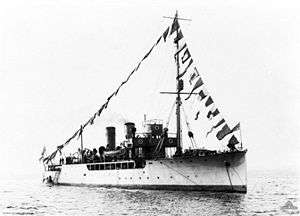HMAS Geranium
HMAS Geranium (formerly HMS Geranium) was an Arabis-class sloop built in Scotland and launched in 1915. The ship was operated by the Royal Navy as a minesweeper from 1915 until 1919, when she was transferred to the Royal Australian Navy (RAN) for use as a survey ship between 1919 and 1927. The ship was decommissioned in 1927 and scrapped during 1932, with the remains scuttled in 1935.
 HMAS Geranium | |
| History | |
|---|---|
| Name: | Geranium |
| Builder: | Greenock & Grangemouth Dockyard Company, Scotland |
| Laid down: | August 1915 |
| Launched: | 8 November 1915 |
| Fate: | Transferred to Australia, 1919 |
| Name: | Geranium |
| Acquired: | 18 October 1919 |
| Commissioned: | 17 January 1920 |
| Decommissioned: | 10 November 1927 |
| Nickname(s): | Gerger |
| Fate: |
|
| General characteristics | |
| Class and type: | Arabis-class sloop |
| Displacement: | 1,250 tons |
| Length: | 267 ft 9 in (81.61 m) o/a |
| Beam: | 33 ft 6 in (10.21 m) |
| Draught: | 11 ft 9 in (3.58 m) |
| Propulsion: |
|
| Speed: | 16.5 knots (30.6 km/h; 19.0 mph) |
| Range: | 2,000 nautical miles (3,700 km; 2,300 mi) at 15 kn (28 km/h; 17 mph) with max. 250 tons of coal |
| Complement: |
|
| Armament: | 2 × 1 - QF 4 inch Mk IV guns, BL 4 inch Mk IX guns or QF 4.7 inch Mk IV guns and 2 × 1 - 3-pounders (47 mm) AA. |
| Aircraft carried: | 1 × Fairey IIID seaplane (RAN) |
Design and construction
Geranium was one of 56 Arabis-class sloops built for the Royal Navy during World War I.[1] The sloops-of-war were intended for minesweeping duties in European waters.[1]
Geranium had a displacement of 1,250 tons.[1] She was 267 feet 9 inches (81.61 m) in length overall, had a beam of 33 feet 6 inches (10.21 m), and a maximum draught of 11 feet 9 inches (3.58 m).[2] The propulsion system consisted of a four-cylinder triple expansion engine, connected to a single propeller shaft.[2] Maximum speed was 16.5 knots (30.6 km/h; 19.0 mph), and the ship could achieve a range of 2,000 nautical miles (3,700 km; 2,300 mi) at 15 knots (28 km/h; 17 mph).[2] Up to 250 tons of coal could be carried.[3]
Geranium was laid down for the Royal Navy by the Greenock & Grangemouth Dockyard Company, Greenock, Scotland, in August 1915 and launched on 8 November 1915.[4]
Operational history
After World War I, Geranium and two sister ships (Mallow and Marguerite) were sent to Australia to clear mines deployed by the German auxiliary cruiser SMS Wolf.[1] Despite hard work in rough seas, the ships only found one mine.[1]
Geranium and the other two ships were transferred to the Royal Australian Navy on 18 October 1919.[1] The ships' minesweeper design made them suitable for handling survey equipment,[1] and Geranium entered RAN service as the navy's first survey ship.[5] The ship was poorly designed for survey duties in tropical Australian waters: she was designed for the North Sea climate, and was required to carry a ship's company of 113, 36 more than the intended ship's company of 77.[1] In 1923, the sloop ran aground on an uncharted reef off Vanderlin Island in the Gulf of Carpentaria.[6] The ship's company were able to refloat the ship and patch the damage, and after repairs in Sydney, the ship resumed northern survey operations.[7] In October, Geranium rescued the civilian steamship Montoro after she struck Young Reef.[7]
In early 1924, the ship ran aground again in the MacArthur River.[7] The ship was refloated and repaired.[7] Later that year, Geranium was fitted to carry a Fairey IIID seaplane: the first RAN survey vessel to carry an aircraft.[8] In May 1927, the survey ship assisted the steamship Tasman, which had hit a reef off Clarke Island.[8]
Decommissioning and fate
Geranium paid off in 1927.[5] The ship was broken up for scrap at Cockatoo Island Dockyard during 1932, and the stripped hulk was sunk as a target in the Tasman Sea outside Sydney Heads on 24 April 1935.[8][9]
Citations
- Frame & Baker, Mutiny!, p. 114
- Bastock, Australia's Ships of War, p. 90
- Frame & Baker, Mutiny!, p. 115
- Bastock, Australia's Ships of War, p. 91
- Bastock, Australia's Ships of War, p. 92
- Frame & Baker, Mutiny!, pp. 118-9
- Frame & Baker, Mutiny!, p. 119
- Frame & Baker, Mutiny!, p. 120
- Gray, Randal, ed., Conway′s All the World′s Fighting Ships, 1906-1921, Annapolis, Maryland: Naval Institute Press, 1985, ISBN 9780851772455, p. 95.